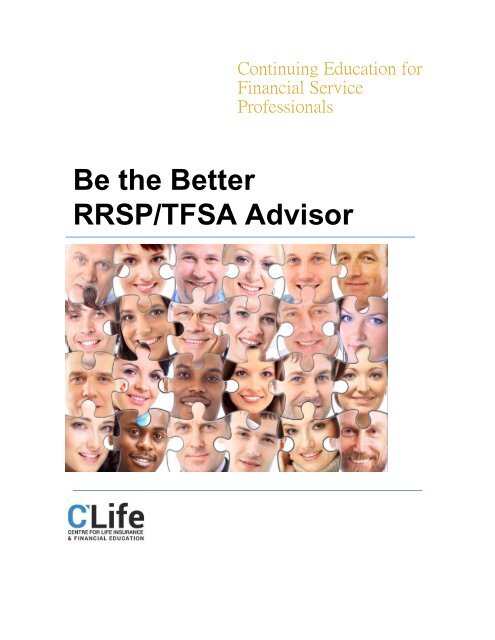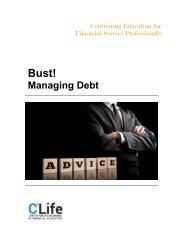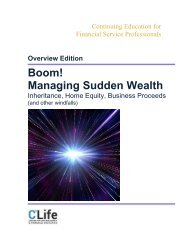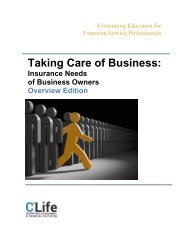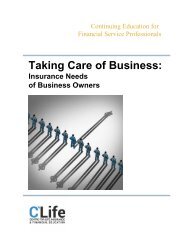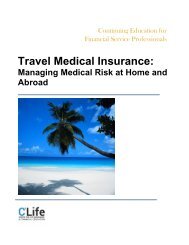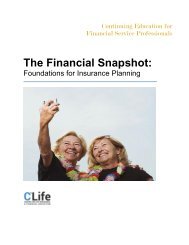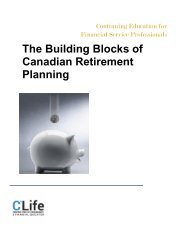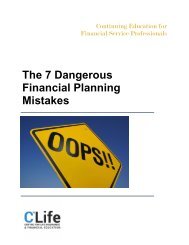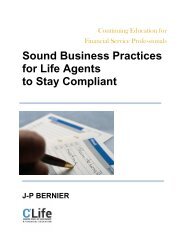Be the Better RRSP/TFSA Advisor
Think the market is saturated? Only one in four Canadians contribute to RRSPs. Many of those who contribute do not fully understand their plan, its options, and its requirements. This course provides a vital review of RRSPs and TFSAs, points of comparison, strategies for use, and details of taxation. Even if you think RRSPs (and TFSAs) are old hat, chances are you’ll find new and important information in this course that can give you an advantage with prospects and clients.
Think the market is saturated? Only one in four Canadians contribute to RRSPs. Many of those who contribute do not fully understand their plan, its options, and its requirements. This course provides a vital review of RRSPs and TFSAs, points of comparison, strategies for use, and details of taxation. Even if you think RRSPs (and TFSAs) are old hat, chances are you’ll find new and important information in this course that can give you an advantage with prospects and clients.
You also want an ePaper? Increase the reach of your titles
YUMPU automatically turns print PDFs into web optimized ePapers that Google loves.
Continuing Education for<br />
Financial Service<br />
Professionals<br />
<strong>Be</strong> <strong>the</strong> <strong>Be</strong>tter<br />
<strong>RRSP</strong>/<strong>TFSA</strong> <strong>Advisor</strong>
Copyright 2016 CLIFE Inc.<br />
All rights reserved. Any reproduction of parts or all of this book and its contents by<br />
any means electronic or mechanical is prohibited.<br />
<strong>Be</strong> <strong>the</strong> <strong>Be</strong>tter <strong>RRSP</strong> and <strong>TFSA</strong> <strong>Advisor</strong> is relevant to all those who work in <strong>the</strong><br />
financial services industry or in association with life insurers. The information in<br />
<strong>the</strong> course is provided for educational purposes only; it should not be construed<br />
or interpreted as providing advice. Agents and advisors should always seek<br />
guidance from <strong>the</strong>ir principals and compliance experts in regards to informing<br />
<strong>the</strong>mselves and o<strong>the</strong>rs about details of <strong>the</strong> products <strong>the</strong>y sell and o<strong>the</strong>r<br />
considerations of <strong>the</strong>ir business.<br />
We welcome all feedback and suggestions for additions to <strong>the</strong> course. Please send<br />
your comments to info@clifece.ca.<br />
CLIFE INC.<br />
1595 Sixteenth Avenue<br />
Suite 301<br />
Richmond Hill, ON<br />
L4B 3N9<br />
www.clifece.ca<br />
<strong>Be</strong> <strong>the</strong> <strong>Be</strong>tter <strong>RRSP</strong> and <strong>TFSA</strong> <strong>Advisor</strong> provides continuing education credits upon satisfactory completion<br />
of an online test. Please see <strong>the</strong> website for details or email info@clifece.ca.<br />
2
Table of Contents<br />
Your Reasons to Take This Course 4<br />
You’re <strong>the</strong> <strong>Be</strong>tter <strong>Advisor</strong>: Now Prove It 7<br />
The Basics 18<br />
Learn from this Real-life <strong>RRSP</strong> Story 19<br />
<strong>RRSP</strong> <strong>Be</strong>nefits 21<br />
Inner Workings of <strong>the</strong> <strong>RRSP</strong> 37<br />
Disadvantages of <strong>RRSP</strong>s 58<br />
<strong>TFSA</strong> <strong>Be</strong>nefits 60<br />
Inner Workings of <strong>the</strong> <strong>TFSA</strong> 64<br />
Disadvantages of <strong>TFSA</strong>s 70<br />
The Real Deal: Which One is <strong>Be</strong>st? 71<br />
The Final Analysis 77<br />
3
Your Reasons to Take This Course<br />
<br />
There’s lots of free <strong>RRSP</strong> and <strong>TFSA</strong> advice available for consumers. Hard<br />
to believe, but <strong>RRSP</strong>s have been available since 1957. Financial<br />
institutions have had more than 58 years to develop <strong>the</strong>ir <strong>RRSP</strong> marketing<br />
materials and develop a cohesive and compelling reason to buy!<br />
<br />
<strong>RRSP</strong>s were available before <strong>the</strong> Canada Pension Plan/Quebec Pension<br />
Plan; CPP/QPP was introduced in 1966.<br />
<strong>TFSA</strong>s are <strong>the</strong> newcomers: <strong>the</strong>y came on to <strong>the</strong> market in 2008.<br />
<br />
Equally hard to believe about <strong>RRSP</strong>s is that <strong>the</strong>y have been around as<br />
long as <strong>the</strong>y have and so many consumers are still so uncertain and<br />
confused about <strong>the</strong>m.<br />
<br />
<strong>RRSP</strong>s may seem “old hat” to you and your financial service colleagues<br />
and <strong>TFSA</strong>s still have some of <strong>the</strong>ir shine but, toge<strong>the</strong>r, <strong>the</strong>re is an<br />
assumption of knowledge about <strong>the</strong>se products and who buys <strong>the</strong>m by<br />
those who sell <strong>the</strong>m.<br />
<br />
One basic, false, assumption is that <strong>RRSP</strong>s and <strong>TFSA</strong>s on <strong>the</strong> whole are<br />
well understood.<br />
<br />
We think it is fair to challenge that thinking.<br />
<br />
Many people do not understand <strong>RRSP</strong>s or <strong>TFSA</strong>s, and in failing to<br />
understand what <strong>the</strong>y are, <strong>the</strong>y do not use <strong>the</strong>m, or begin and quit from a<br />
sense of frustration.<br />
4
Even highly educated professionals make serious and expensive mistakes<br />
when it comes to <strong>RRSP</strong>s and maturity options.<br />
<br />
The <strong>RRSP</strong>/<strong>TFSA</strong> market is not saturated. Many sales opportunities exist<br />
and arise on an ongoing basis. They include:<br />
o Those who have never established plans;<br />
o Those who have plans that are languishing without making fur<strong>the</strong>r<br />
contributions or because <strong>the</strong>y are not managing investment<br />
performance;<br />
o Those whose economic circumstances improve and find<br />
<strong>the</strong>mselves in a position to contribute;<br />
o Those whose employment circumstances change and find<br />
<strong>the</strong>mselves no longer contributing to a company pension;<br />
o Those whose personal circumstances change and find <strong>the</strong>y have<br />
extra income available for saving because, for instance, child care<br />
costs decrease;<br />
o New Canadian citizens.<br />
Fur<strong>the</strong>r, <strong>the</strong> Insurance & Investment Journal reported on October 2015<br />
(http://insurance-journal.ca) that fewer than one in four Canadian<br />
contribute to <strong>RRSP</strong>s.<br />
o Just 61% of those who earn $80,000 or more were contributors ---<br />
a decrease of 7% in ten years;<br />
o Only 16% of those who earn between $20,000 and $40,000 were<br />
contributors --- a decrease of 25% in ten years!<br />
<br />
<strong>TFSA</strong> contributions are growing but even so:<br />
o Only 30% of those earning $80,000 or more contributed to <strong>the</strong>ir<br />
<strong>TFSA</strong>;<br />
o 26% of those with income between $20,000 and $40,000<br />
contributed.<br />
5
The Office of <strong>the</strong> Chief Actuary, a unit of <strong>the</strong> Office of <strong>the</strong> Superintendent<br />
of Financial Institutions, found that <strong>the</strong> percentage of employees covered<br />
by a registered pension plan has declined from 39% in 2003 to 38% in<br />
2013. Therefore, pension coverage at work is in decline.<br />
<br />
A study by BlackRock called <strong>the</strong> Global Investor Pulse Survey found that<br />
40% of Canadians age 55-64 have no retirement savings.<br />
<br />
Where do you come in? Perhaps by starting with some basic information,<br />
since 58% of those in <strong>the</strong> BlackRock survey admitted <strong>the</strong>y do not fully<br />
understand how much <strong>the</strong>y need to save for retirement.<br />
<br />
Let’s repeat: <strong>the</strong>re’s lots of room in <strong>the</strong> market for <strong>the</strong>se plans.<br />
<br />
The objective of this course is to lay out all <strong>the</strong> details of <strong>RRSP</strong>s and<br />
<strong>TFSA</strong>a and provide points of comparison between <strong>the</strong>m. Careful reading<br />
of how to use plan features and benefits will make you <strong>the</strong> better<br />
<strong>RRSP</strong>/<strong>TFSA</strong> adviser.<br />
<br />
To some, this course may be financial advisory back-to-basics, yet it is<br />
important to bear in mind that it is basics on which success is built.<br />
“ Success is nei<strong>the</strong>r magical nor mysterious. Success is <strong>the</strong> natural<br />
consequence of consistently applying <strong>the</strong> basic fundamentals.”<br />
Jim Rohn<br />
6
You’re <strong>the</strong> <strong>Be</strong>tter <strong>Advisor</strong>: Now Prove It<br />
<br />
We’ve pointed out that financial institutions have had decades to get <strong>the</strong>ir<br />
<strong>RRSP</strong> information kits prepared. Undoubtedly, <strong>the</strong>y are highly valuable in<br />
<strong>the</strong> information <strong>the</strong>y provide.<br />
<br />
What <strong>the</strong>y don’t provide is <strong>the</strong> benefit of interpersonal interaction such as<br />
that which is created when you sit in front of your prospects or clients<br />
(P&Cs). You impart information but, more importantly, you can read <strong>the</strong>ir<br />
facial expressions and body language to decipher if your message is<br />
hitting home.<br />
<br />
You do this not just when <strong>RRSP</strong> season comes around but also every<br />
time you meet with your P&Cs. This gives you unique abilities to provide<br />
assurance, answer questions, and understand motivations.<br />
<br />
In short, you have <strong>the</strong> advantage of knowing your client.<br />
<br />
You can better know your client by meeting on a regular basis and asking<br />
questions like:<br />
o Do you contribute to a company pension plan?<br />
o Is <strong>the</strong> company you are working for growing, flat, or shrinking?<br />
o Is <strong>the</strong> industry in which <strong>the</strong> company works growing, flat, or<br />
shrinking?<br />
o Is <strong>the</strong>re job security at work?<br />
o Do you receive an annual bonus or on-going commission?<br />
<br />
But, here’s an alarming fact from <strong>the</strong> Canadian Life and Health Insurance<br />
Association (CLHIA): In a survey conducted within <strong>the</strong> last three years,<br />
75% of those surveyed said <strong>the</strong>y look to <strong>the</strong>ir advisor for financial advice<br />
7
and on average it had been five years since <strong>the</strong>y were approached about <strong>the</strong>ir<br />
needs and coverages.<br />
<br />
Question: How do you know what’s happening in a client’s life if you are not<br />
in regular contact?<br />
<br />
An initial meeting or series of meetings when your relationship is beginning<br />
sets a benchmark. But without a regular review and knowledge about whe<strong>the</strong>r<br />
client circumstances have changed --- improved or deteriorated --- you don’t<br />
know if <strong>the</strong> ground has shifted. There may be entire earthquakes of which you<br />
are unaware!<br />
<br />
An annual review satisfies your need for knowledge.<br />
<br />
You can set yourself apart from your competitors by establishing <strong>the</strong> need for<br />
review; demonstrate that you are consultative. In return, you will develop a<br />
client base who appreciates your advice and consultation. This will be<br />
especially true for products like <strong>RRSP</strong>s and <strong>TFSA</strong>s, which are so widely<br />
available.<br />
<br />
The annual review gives you <strong>the</strong> opportunity to be proactive and engage in a<br />
relationship instead of employing transactional selling.<br />
o Transactional selling is a sales strategy that produces quick sales<br />
without developing a long-term customer relationship.<br />
o Relationship, or consultative selling, is a continuum that maps out<br />
plans and focusses on progress towards goals.<br />
8


